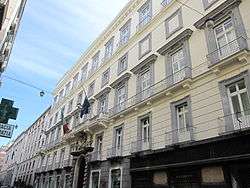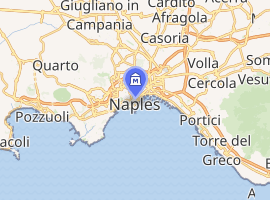Palazzo Zevallos Stigliano
The Palazzo Zevallos Stigliano is a Baroque palace located on Via Toledo number 185 in the quartiere San Ferdinando of central Naples, Italy. It is also called the Palazzo Zevallos or Palazzo Colonna di Stigliano, and since 2014 serves as a museum of artworks, mainly spanning the 17th through the early 20th centuries, sponsored by the Cultural Project of the bank Intesa Sanpaolo. This museum is linked to the Museum or Gallerie di Piazza Scala in Milan and the Museum at Palazzo Leoni Montanari in Vicenza, also owned by the Bank.
Palazzo Zevallos Stigliano | |
 Façade | |

| |
| Established | 1989 |
|---|---|
| Location | Via Toledo 185, Napoli, Italy |
| Coordinates | 40.8397°N 14.2486°E |
| Type | Art museum, Historic site |
| Website | Official website |
History
The palace was commissioned by Giovanni Zevallos, Duke of Ostuni. The external portal of the palace still sports his family's heraldic shield. During 1637-1639, the palace was built according to designs of Cosimo Fanzago. The palace was damaged during the 1646 Revolution of Masaniello, and in 1653 sold to the Flemish merchant Giovanni de Vandeneynden, whose daughter married the Prince of Sonnino, Don Giuliano Colonna, who then inherited the palace in 1688.
Over the decades following the end of the 19th century, the palace was acquired by the Banca Commerciale Italiana, and reconstruction was pursued under architect Luigi Platania. The facade acquired its present look, and a monumental marble staircase was installed, which is surrounded by 19th century frescoes by Giuseppe Cammarano and Gennaro Maldarelli. The frescoes include Cammarano's Apotheosis of Sappho (1832). The courtyard was made into a stunning covered public hall vaulted by a glass ceiling with a floral motifs. The palace became a public museum and gallery. In 2001 Banca Intesa, became the Intesa Sanpaolo.
Collections
Among the works contained in the gallery are:[1]
- The Martyrdom of Saint Ursula by Caravaggio, thought to be his final work
- Judith and Holofernes, attributed to Louis Finson, which may be a copy of a Caravaggio original
- Holy Family with St Francis of Assisi, by Angelo Caroselli
- Christ and the Adulturess by Bernardo Cavallino
- San Giorgio by Francesco Guarini
- Adorazione dei Magi attributed to Master of the Annunciation to the shepherds
- Tobias heals his father's blindness by Hendrick de Somer
- Two still-life canvases by Paolo Porpora
- Still life with bread, fruit, game, and fish by Giovan Battista Ruoppolo
- Two still lifes by Giuseppe Recco
- Still-lifes with Vases of Flowers (1715) by Baldassare De Caro
- Hagar and Ishmael in Desert with Angel by Francesco Solimena
- The secret letter and The Concert by Gaspare Traversi
- Four Veduta of Naples including Largo di Palazzo and il borgo di Chiaia da Pizzofalcone (1729) by Gaspare van der Wittel (Vanvitelli)
- Landscape by Anton Sminck Pitloo
- Four water color landscapes by Giacinto Gigante
- Landscape with laghetto by Nicola Palizzi
- La terrazza di Domenico Morelli by Achille Carrillo
- Isabella Orsini duchessa di Bracciano (1844) by Francesco Domenico Guerrazzi
- Landscapes by Federico Rossano
- Landscapes by Marco De Gregorio
- Landscape by Giuseppe De Nittis
- Landscapes by Gioacchino Toma
- Landscape by Giuseppe Fabozzi
- Landscape by Francesco Mancini
- Portrait of painter Vincenzo Migliaro by Gaetano Esposito
- Two self-portraits by Francesco Paolo Michetti
- Woman with fan by Domenico Morelli
- Two capricci of antique monuments by Vincenzo Abbati and Domenico Battaglia
- Work by Paolo Vetri
- Urban vedute by Carlo Brancaccio, Francesco Mancini, Francesco Paolo Diodati and Vincenzo Migliaro
- Frescoes of Faith by Giuseppe Cammarano and Gennaro Maldarelli
- Portraits of Mariano Fortuny and Domenico Morelli, by Vincenzo Gemito
- Kidnapping of Helen and Immaculate Conception by Luca Giordano
- Christ Blessing by Francesco Di Maria
- Four allegories of Faith (ovals, 1759) by Francesco De Mura from Sala delle Udienze of the Palazzo Monte di Pieta, Naples